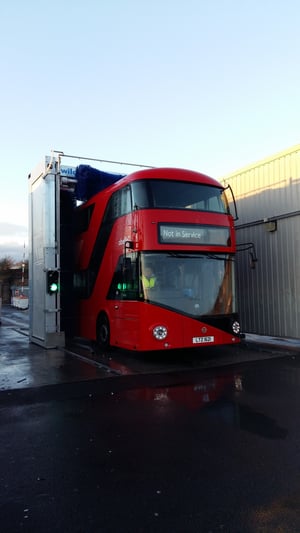When it comes to washing, bus operators face a unique set of challenges compared with operators of other vehicle types. With bus fleets often hundreds-strong, a high throughput is crucial for any wash system to be able to process every bus in a timely manner. In addition, bus depots are often fairly small because of their city-centre locations - making the process of washing, fuelling and parking a logistical headache.
Because on-site space is at a premium, it’s common for the wash bay itself to also be small, which can present problems when it comes to guaranteeing the speed and quality of wash required. But there is a solution to this issue, in the form of advanced semi-stationary wash systems.
What is a semi-stationary wash system?
A semi-stationary wash system is the perfect solution for processing large vehicles in a confined wash bay. The wash is completed in three separate parts:
- The driver manoeuvres the bus into the wash bay before stopping. The brushes then wash the front of the vehicle.
- As the bus moves through the wash bay, the machine washes its sides and roof.
- The bus stops again, allowing the machine to complete the wash - by washing the rear of the vehicle.
The mechanics of the system are almost identical to a stationary rollover gantry, with brushes rolling over and around the vehicle to complete a comprehensive wash. Operators can still guarantee a consistent wash every time, with the electronically-controlled brushes applying the perfect amount of pressure to gently contour the vehicle, protecting any auxiliary components from damage.

The benefits of semi-stationary systems for small wash bays
The most advanced semi-stationary wash systems, like the Christ Magnum that Wilcomatic supplies, are extremely suited to washing large buses in small bays. Such systems are configured to perfectly deliver fast, effective and high quality washes:
- The wash process begins as soon as the bus is in place - meaning no external operators are required and a high throughput of buses can be maintained.
- There is no need for the driver to leave the vehicle - unlike more rudimentary systems, there is only minimal delay between each phase of the wash.
- No maximum bay size is required - whereas a stationary system requires a bay 5m longer than the fleet’s longest bus, semi-stationary systems offer considerable compromise on this.
Higher-end semi-stationary gantries offer serious time savings over systems at the lower end of the market. In fact, Wilcomatic were able to install a bespoke solution for Go South Coast which completes a full wash in just 2 and a half minutes, compared to the six minutes it takes for less advanced systems.
How Wilcomatic deliver the best in bus wash systems
Wilcomatic have over half a century’s worth of experience in delivering world class wash systems - meaning there’s no better choice when it comes to bus wash projects.
Our team of highly-skilled engineers will work closely with you to understand your exact requirements, taking into consideration the layout of your site and your existing infrastructure. We will do whatever it takes to deliver the most effective solution for your fleet, offering a full turnkey package of civil works, design & installation and any additional building works. We are able to install a semi stationary system in a bay as small as just 8m long.
We are the UK’s exclusive supplier of Otto Christ’s market-leading wash solutions, meaning we build our wash systems with the most advanced technology available. To learn more about how we can deliver the ideal solution for your bus fleet, with a range of finance options, contact our team today.